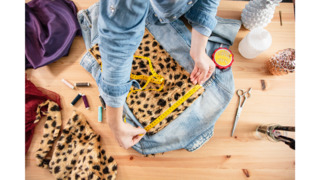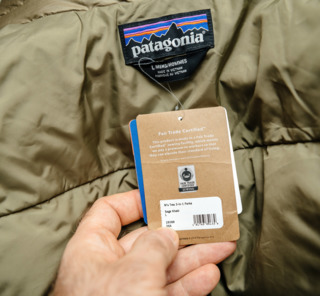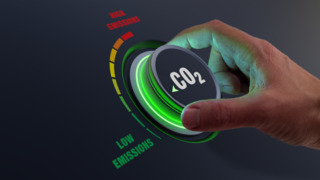Resizing Our Carbon Footprint

I recently read a Fortune op-ed that truly alarmed me and prompted me to write this article. Patagonia, which has long been held up as a model for a sustainable future, was one of the first – most likely the first – clothing brand to put a take-back program in place with its Worn Wear website. This gives customers the opportunity to return merchandise that is in good condition in exchange for new merchandise credits, with the company cleaning, repairing and selling the used items.
Fast forward to today, and the alarming Fortune op-ed. Beth Thoren, environmental action and initiatives director, EMEA, for Patagonia, stated that at Patagonia, they don’t use the word “sustainable.” For a company that has long been held up as a sustainability example, that is alarming. But even more so is the reason why.
It's because we recognize we are part of the problem. Previously, we set ourselves the target of carbon neutrality by 2025. But purchasing offsets to get us there doesn’t erase the footprint we create and won’t save us in the long run. We must first put the weight of our business behind drastically cutting emissions across the full length of our supply chain.
What is unsettling is that, right now, we aren’t entirely sure how to do this.
Thoren cites the fact that recycled content comprises 68% of total usage – quite an achievement, but still not enough. And if Patagonia doesn’t know how, who does?
With that question in mind, I recently spoke to Tiffany Hua, senior research associate at Lux Research, and the analyst focused on textiles and apparel, contributing to the company’s recent 2022 Foresight Report. The report highlights analyses and predictions from Lux Research on emerging technologies and potential scenarios that might unfold in 2022.
Throughout the report, the analyses are structured via the Lux Sustainable Innovation Model, which is comprised of three key pillars: Climate Tech, Circular Economy and Future Consumer Tech.
“These three pillars represent the priorities that corporate leaders should put front and center when developing their sustainability strategies,” Hua said.
According to Hua, The Climate Tech pillar focuses on technologies that support the elimination and remediation of greenhouse gas (GHG) emissions. The Circular Economy track focuses on circular solutions and business models that reduce and eliminate waste and optimize resource consumption. The Future Consumer track focuses on supporting health, wellness, safety and transparency across a number of industries.
Note that digital transformation is integral across these three pillars. Data and being able to measure and manage one’s impact is at the center of achieving sustainability.
The Sustainable Innovation Model is embedded in Lux Research’s business, where Hua looks at the textiles and apparel industry through this lens.
Hua said that large apparel brands are being pressured to solve the industry’s sustainability challenges, where building a sustainable innovation strategy is key to surviving.
Key Sustainability Challenges for Textiles & Apparel
Hua identified key challenges for textiles and apparel in 2022 and beyond, relative to achieving sustainability goals.
Referring back to Lux’s Sustainability Innovation Model, Hua said that companies in the apparel and textile industry must form a sustainable strategy. First, she said, apparel brands have to gain visibility within their own supply chains. This was exactly the challenge Patagonia identified in its recent op-ed, citing the fact that 95% of its emissions come from its supply chain, within which Patagonia is a minor player that produces in shared factories, often alongside large brands.
“Transparency and digitalization via auditing of supply chains give an organization the full picture of supply chain risks and fragilities when developing long-term strategies," Hua said. "While companies can tackle transparency and sustainability internally, we can expect to see additional efforts to create a more transparent, flexible and resilient supply chain. Transparency is the first step to understanding the sustainability impact of raw material and processing of textiles. Transparency will also help to understand and to gather more information on the material lifecycle assessment.”
Another challenge is the broad availability of sustainable materials.
“[Use of] sustainable materials and fibers will continue to increase as many companies have made commitments to move to sustainable materials by 2025 or 2030," Hua said. "Many apparel brands currently use what is available today at scale - recycled polyester made from plastic water bottles and cotton certified as sustainable by organizations like the Better Cotton Initiative. But the simple fact is that there are not enough sustainable offerings currently on the market at scale and at a reasonable cost, with more demand than supply for these sustainable materials. In 2022, we can expect apparel brands to struggle to identify and acquire more sustainable materials.”
Finally, Hua identified textile recovery and recycling as a sustainability barrier for textiles and apparel.
According to Hua, textile recovery and recycling is the key to unlocking the circular economy in the apparel industry. However, recovering and recycling a garment is not that simple. Many garments are made from multiple material types and have accessories, such as buttons and zippers that must be removed prior to any recycling.
Meanwhile, the textile recovery infrastructure and recovery technologies are still a work in progress, although she expects we will see innovations in the next year focused on waste management, including textiles.
In addition to processes that collect and separate textiles, there is a huge technical challenge in the recycling of textiles – especially synthetic and blended textiles like poly/cotton blends. To truly recycle these garments back into garments and not downcycled products, chemical or advanced recycling processes must be used. Polyester, for example, must be chemically reduced down to its petrochemical base and reconstructed as new fibers that fit into the circular economy model.
Development is underway by several companies, including Worn Again, Ambercycle and Circ, to address this issue of separating the polyester from the cotton, using chemicals or heat. These developers claim their advanced recycling methods result in little material loss and a quality of yarn that is almost undistinguishable from virgin feedstocks.
Another option is mechanical recycling, which does not use any chemicals. Most mechanical recycling, however, is limited to downcycled products, like insulation or carpet padding. But there are some companies, like Circular System’s Texloop and Pure Waste Textiles, that are targeting quality fibers from mechanical recycling technologies. This involves shredding and carding to extract fibers from the fabric, and then spinning the resulting fibers into yarn. Waste fabric can also be shredded and downcycled to insulation, carpet padding and a variety of other uses that extends the fiber life and contributes to landfill diversion.
There Are Other Options …
First and foremost, we need to eliminate the concept of fast fashion from our closets and our production mindsets. Producing cheap clothing that doesn’t last, and is perhaps worn only once, is clearly not a sustainable model.
Other options for improving sustainability for textiles and apparel, in addition to efforts to reduce GHG emissions across the entire supply chain, include the following:
⦁ Brand take-back programs. More brands should follow the lead of companies like Patagonia, Levi’s and Eileen Fisher in establishing these programs. Not only do they extend the life of garments, but they also increase brand loyalty. Another advantage is the fact that brands know exactly what fibers and materials are used in a particular garment, and at the point they need to be recycled, they can more easily find the best way to get that done.
⦁ Resale. Brands can re-sell garments they receive as part of their take-back programs. But there is a growing consumer-driven market for resale, facilitated by apps such as DePOP, real-real, Poshmark, ThredUP and more. ThredUP has an aggressive Resale-as-a-Service (RaaS) program with a wide range of partners that helps keep apparel items out of landfill.
⦁ Upcycling. “Recycling breaks products down into their raw materials to be made into totally new things, while upcycling creatively repurposes old materials while maintaining some of their original characteristics,” according to EarthHero. An example in apparel is San Francisco-based unspun. Not only do a pair of unspun jeans naturally have a longer life cycle, since they are custom fitted to the consumer via 3D imaging technologies, but the company has a take-back program that includes upcycling – turning a pair of jeans into cut-offs that can be resold, for example. The company is also using thread that dissolves with heat to make disassembly more efficient.
Another option is to find new homes for unwanted apparel through programs like Boston-based SwagCycle, a platform that matches donors with recipients for materials that can be re-used or recycled, giving them a second life and keeping them out of the landfill. This includes such things as donations to charities like Dress for Success and Boys & Girls Clubs, to finding ways to use ground-up materials in insulation, mattress stuffing, carpet pads and more.
There is hope for improved sustainability in textiles and apparel, but it is not without its challenges. Obviously, a major need is to get a handle on how to make the supply chain more sustainable. But the efforts to establish take-back programs and find ways to recycle, resell and upcycle garments are not trivial either, and present options for all of us to participate in this important effort.


